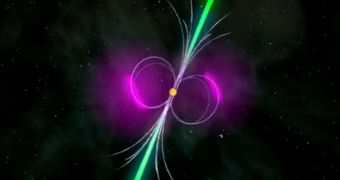Millisecond pulsars are a special type of a special class of neutron stars. They are revolving around their own axis many times per second, and are releasing radiations in jets, which makes them appear as lighthouse when viewed from Earth. Now, experts find how these objects slow down.
Pulsars are very difficult to study, as are neutron stars and magnetars as well. These fast-spinning object are apparently only able to slow down by losing some of their mass, and gradually disintegrating as this happens.
Large chunks of the small stars are cast away into space, reducing its mass, and increasing the rate at which its rotational speed decreases. All types of neutron stars are produced following the core-collapse of a star, which usually occurs in a supernova explosion.
If the progenitor star is not massive enough, then the phenomenon will not produce a black hole, but a neutron star instead. If the latter is in a binary system and continuously accretes mass from its companion, then it may eventually grow large enough to collapse again, this time into a black hole.
But neutrons are extremely dense in neutron stars as well. A single tablespoon of matter from such an object would weight in excess of 100 million tons, or about as much as a medium-sized mountain.
When accreting mass from companions, neutron stars start to emit a lot of X-rays, and then go on to spin at extremely high speed, of between 100 and 1,000 turns per second. This is why the fastest of them are called millisecond pulsars.
The objects slow down only after they consume the outer envelope of their companion stars. University of Bonn astrophysicist Thomas Tauris reveals in a new study that dying pulsars can lose up to half of their rotational energy over relatively brief periods of time.
Matter starts being lost because accretion-driven growth exerts a braking torque on the millisecond pulsars, Space reports. Details of this work appeared in the February 3 issue of the top journal Science.
“Now we know that the very same process responsible for spinning up old neutron stars to extraordinary fast spin rates with periods of 1 to 10 milliseconds is actually also causing the millisecond pulsars to spin down again,” Tauris explains.

 14 DAY TRIAL //
14 DAY TRIAL //